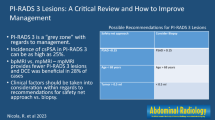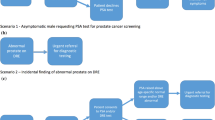Abstract
Purpose
Compared to low-grade disease, high-grade prostate cancers exhibit a higher rate of disease progression. As a result, there has been a trend to treat high-risk disease with methods other than surgery. The purpose of this study is to evaluate the long-term survival following radical prostatectomy (RRP) for non-metastatic Gleason 8–10 prostate adenocarcinoma (CaP).
Methods
All patients 75 years or less with Gleason 8–10 CaP that underwent RRP were identified from the SEER 18 database. Patients with metastatic disease, those who underwent other modalities of treatment, or with more than one primary cancer, were excluded. Data were analyzed for demographics, stage at presentation, treatment modality, and overall survival and cancer-specific survival.
Results
A total of 30,379 men met inclusion criteria. Mean age was 62.5 years and 82.5 % of patients were white. A total of 52.8 % of patients had T2 disease, and 73.1 % had node-negative disease, 80.2 % of patients underwent pelvic lymph node dissection, and 12.9 % underwent adjuvant radiation therapy. Overall survival for the entire cohort was 92.8, 78.6, 59.5, 38.6, and 20.0 % for 5, 10, 15, 20, and 25 years, respectively. Cancer-specific survival was 96.4, 89.5, 82.0, 72.9, and 68.8 % for 5, 10, 15, 20, and 25 years, respectively.
Conclusions
Although historically underutilized in patients with poorly differentiated disease, radical prostatectomy provides excellent long-term survival and should be offered to healthy patients.





Similar content being viewed by others
References
Siegel R, Naishadham D, Jemal A (2012) Cancer statistics, 2012. CA Cancer J Clin 62:10–29
Epstein JI, Carmichael MJ, Pizov G et al (1993) Influence of capsular penetration on progression following radical prostatectomy: a study of 196 cases with long-term follow-up. J Urol 150(1):135–141
Sgrignoli AR, Walsh PC, Steinberg GD et al (1994) Prognostic factors in men with stage D1 prostate cancer: identification of patients less likely to have prolonged survival after radical prostatectomy. J Urol 152:1077–1081
Albertsen PC, Hanley JA, Gleason DF et al (1998) Competing risk analysis of men aged 55 to 74 years at diagnosis managed conservatively for clinically localized prostate cancer. JAMA 280:975
Hull GW, Rabbani F, Abbas F et al (2002) Cancer control with radical prostatectomy alone in 1,000 consecutive patients. J Urol 167:528
Sweat SD, Bergstralh EJ, Slezak J, Blute ML, Zincke H (2002) Competing risk analysis after radical prostatectomy for clinically nonmetastatic prostate adenocarcinoma according to clinical Gleason score and patient age. J Urol 168:525–529
Paulson DF, Piserchia PV, Gardner W (1980) Predictors of lymphatic spread in prostatic adenocarcinoma: uro-oncology research group study. J Urol 123:697
Sogani PC, Israel A, Lieberman PH et al (1985) Gleason grading of prostate cancer: a predictor of survival. Urology 25:223
Meng MV, Elkin EP, Latini DM, Duchane J, Carroll PR (2005) Treatment of patients with high risk localized prostate cancer: results from cancer of the prostate strategic urological research endeavor (CaPSURE). J Urol 173:1557–1561
Manoharan M, Bird VG, Kim SS, Civantos F, Soloway MS (2003) Outcome after radical prostatectomy with a pretreatment prostate biopsy Gleason score of ≥8. BJU Int 92:539–544
Boorjian SA, Karnes RJ, Crispen PL, Rangel LJ, Bergstralh EJ, Sebo TJ et al (2009) The impact of discordance between biopsy and pathological Gleason scores on survival after radical prostatectomy. J Urol 181:95–104
Donohue J, Bianco F, Kuroiwa K et al (2006) Poorly differentiated prostate cancer treated with radical prostatectomy: long term outcome and incidence of pathological downgrading. J Urol 176(3):991–995
Bill-Axelson A, Holmberg L, Ruutu M, Haggman M, Andersson SO, Bratell S et al (2011) Radical prostatectomy versus watchful waiting in early prostate cancer. N Engl J Med 364:1708–1717
Tewari A, Divine G, Chang P et al (2007) Long-term survival in men with high grade prostate cancer: a comparison between conservative treatment, radiation therapy and radical prostatectomy—a propensity scoring approach. J Urol 177(3):911–915
Shao YH, Kim S, Moore D et al (2013) Cancer-specific survival after metastasis following primary radical prostatectomy compared with radiation therapy in prostate cancer patients: results of a population-based, propensity score–matched analysis. Eur Urol. Online 21 May 2013. ISSN 0302-2838. doi:10.1016/j.eururo.2013.05.023
Mian BM, Troncoso P, Okihara K et al (2002) Outcome of patients with Gleason score 8 or higher prostate cancer following radical prostatectomy alone. J Urol 167:1675–1680
Lughezzani G, Gallina A, Larcher A et al (2013) Radical prostatectomy represents an effective treatment in patients with specimen-confined high pathological Gleason score prostate cancer. BJU Int 111(5):723–730
Gerber GS, Thisted RA, Scardino PT et al (1996) Results of radical prostatectomy in men with clinically localized prostate cancer. JAMA 276:615
Grossfeld GD, Chang JJ, Broering JM et al (2000) Impact of positive surgical margins on prostate cancer recurrence and the use of secondary cancer treatment: data from the CaPSURE database. J Urol 163:1171–1177
Boorijan SA, Thompson RH, Siddiqui S et al (2007) Long-term outcome after radical prostatectomy for patients with lymph node positive prostate cancer in the prostate specific antigen era. J Urol 178(3):864–870
Brimo F, Partin AW, Epstein JI (2010) Tumor grade at margins of resection in radical prostatectomy is an independent predictor of prognosis. Urology 76(5):1206–1209
Pierorazio PM, Ross AE, Schaeffer EM et al (2011) A contemporary analysis of outcomes of adenocarcinoma of the prostate with seminal vesicle invasion (pT3b) after radical prostatectomy. J Urol 185(5):1691–1697
Hubanks M, Boorjian SA, Frank I et al (2013) The presence of extracapsular extension is associated with an increased risk of death from prostate cancer after radical prostatectomy for patients with seminal vesicle invasion and negative lymph nodes. Urol Oncol. Online 6 February 2013. ISSN 1078-1439. doi:10.1016/j.urolonc.2012.09.002
Lau WK, Bergstralh EJ, Blute ML, Slezak JM, Zincke H (2002) Radical prostatectomy for pathological Gleason 8 or greater prostate cancer: influence of concomitant pathological variables. J Urol 167:117
Schiavina R, Scattoni V, Castellucci P et al (2008) 11C-choline positron emission tomography/computerized tomography for preoperative lymph-node staging in intermediate-risk and high-risk prostate cancer: comparison with clinical staging nomograms. Eur Urol 54(2):392–401
Cheng L, Zincke H, Blude M et al (2001) Risk of prostate carcinoma death in patients with lymph node metastasis. Cancer 91(1):66–73
Briganti A, Karnes J, Filippo Da Pozzo L et al (2009) Two positive nodes represent a significant cut-off value for cancer specific survival in patients with node positive prostate cancer. A new proposal based on a two-institution experience on 703 consecutive N+ patients treated with radical prostatectomy, extended pelvic lymph node dissection and adjuvant therapy. Eur Urol 55(2):261–270
Daneshmand S, Quek M, Stein J et al (2004) Prognosis of patients with lymph node positive prostate cancer following radical prostatectomy: long term results. J Urol 172(6):2252–2255
Acknowledgments
All authors of this research paper have directly participated in the planning, execution, or analysis of this study. All authors of this paper have read and approved the final version submitted. There are no directly related manuscripts or abstracts, published or unpublished, by any author(s) of this paper. The contents of this manuscript have not been copyrighted or published previously; are not now under consideration for publication elsewhere; and will not be copyrighted, submitted, or published elsewhere, while acceptance by the Journal is under consideration.
Conflict of interest
There is no actual or potential conflict of interest in relation to this article.
Author information
Authors and Affiliations
Corresponding author
Rights and permissions
About this article
Cite this article
Pokala, N., Trulson, J.J. & Islam, M. Long-term outcome following radical prostatectomy for Gleason 8–10 prostatic adenocarcinoma. World J Urol 32, 1385–1392 (2014). https://doi.org/10.1007/s00345-014-1253-1
Received:
Accepted:
Published:
Issue Date:
DOI: https://doi.org/10.1007/s00345-014-1253-1




